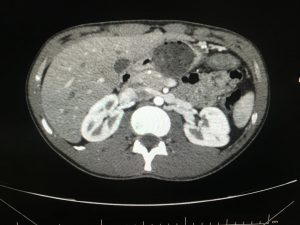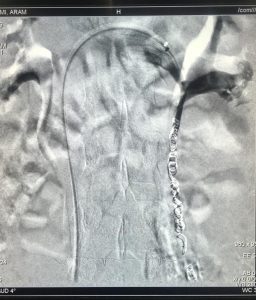
CASE OF THE DAY 3 Nov
Question:
A 21 years old man with two times surgery and recurrence of his problem.
Which kind of intervention has been done and why?


- Answer:
2) Nut cracker syndrome and embolization of the left gonadal vein.
(Recurrent varicocele was the patient’s problem)
- Findings:
- A) Axial Ct scan with IV contrast (portovenous phase): Renal vein is relatively dilated and compressed when passing between the superior mesenteric artery and the abdominal aorta. There is a bundle of varicose veins (arising from the left gonadal vein) medial to the left kidney.
- Fluoroscopy image shows selective catheterization of the left gonadal vein which indicates successful embolization of left side gonadal vein with coils and dilated left renal vein.
- Discussion:
- Nutcracker syndrome is a vascular compression disorder that refers to the compression of the left renal vein most commonly between the superior mesenteric artery (SMA) and aorta. It is most commonly manifested by left flank and abdominal pain, usually but not implicitly accompanied by macroscopic or microscopic hematuria. Compression of the LRV may also causes left renal vein hypertension. The left testicular vein drains into the left renal vein (LRV). Extrinsic compression of the LRV is a potential cause of back pressure leading to a left testicular varicocele which is actually refractory to surgical management. Varicocele embolization is best reserved to treat varicocele refractory to surgical management.
- Fong JK, Poh AC, Tan AG, et al. Imaging findings and clinical features of abdominal vascular compression syndromes. AJR Am J Roentgenol 2014;203:29-36.
- Perdikakis E, Tzortzis V, Rountas C. Varicocele embolization: Anatomical variations of the left internal spermatic vein and endovascular treatment with different types of coils. Diagnostic and Interventional Imaging 2018;99:599-607.
- Al-Naser, S.Haddad , F.KhoriInt, et al. Comparing between varicocele surgery and embolization , our experience in King Hussein medical center. J Med Invest 2017;6:1-15.
Courtesy of Hadi Rokni, MD, Full Professor Department of Radiology, Imam Khomeini Hospital Tehran University of Medical Sciences.
